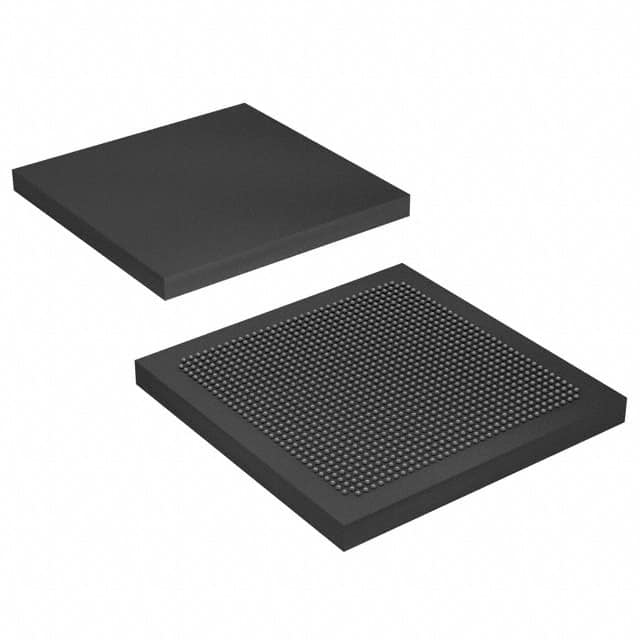Viz Specifikace pro podrobnosti o produktu.

5SGXEA4K2F35I3N
Product Overview
- Category: Field Programmable Gate Array (FPGA)
- Use: Digital logic circuits, prototyping, and system integration
- Characteristics: High-performance, reprogrammable, customizable
- Package: BGA (Ball Grid Array)
- Essence: Advanced programmable integrated circuit for digital design
- Packaging/Quantity: Single unit per package
Specifications
- Manufacturer: Intel Corporation
- Family: Stratix V
- Device Name: 5SGXEA4K2F35I3N
- Logic Elements: 462,000
- Embedded Memory: 8,062,464 bits
- DSP Blocks: 1,288
- Maximum User I/O Pins: 1,280
- Operating Voltage: 1.0V
- Operating Temperature: -40°C to 100°C
- Package Size: 35mm x 35mm
Detailed Pin Configuration
The 5SGXEA4K2F35I3N FPGA has a complex pin configuration with multiple pins dedicated to various functions. The detailed pin configuration can be found in the manufacturer's datasheet.
Functional Features
- High-speed performance: The FPGA offers fast processing capabilities, making it suitable for applications requiring real-time data processing.
- Reprogrammability: The device can be reconfigured multiple times, allowing for flexibility in design changes and updates.
- Customizability: Users can create their own digital logic circuits by programming the FPGA, enabling tailored solutions for specific applications.
- Integration: The FPGA can be seamlessly integrated into existing systems, facilitating system-level design and prototyping.
Advantages and Disadvantages
Advantages
- Versatility: The FPGA can be used in a wide range of applications, including telecommunications, aerospace, automotive, and industrial sectors.
- High-performance: The device offers high-speed processing capabilities, enabling complex computations and data manipulation.
- Cost-effective: FPGA-based solutions can be more cost-effective compared to custom ASIC designs for low-to-medium volume production.
Disadvantages
- Complexity: Programming and configuring an FPGA requires expertise in digital design and HDL (Hardware Description Language).
- Power consumption: FPGAs tend to consume more power compared to dedicated application-specific integrated circuits (ASICs) for the same functionality.
- Limited resources: The available logic elements, memory, and I/O pins may impose constraints on the complexity and scale of designs.
Working Principles
The 5SGXEA4K2F35I3N FPGA operates based on the principles of reconfigurable computing. It consists of an array of programmable logic blocks interconnected through configurable routing resources. The user programs the FPGA using a hardware description language (HDL) to define the desired digital logic circuitry and interconnections. Upon configuration, the FPGA executes the programmed logic, performing various computational tasks as per the application requirements.
Detailed Application Field Plans
The 5SGXEA4K2F35I3N FPGA finds applications in diverse fields, including:
- Telecommunications: Used for high-speed data processing in network routers, switches, and base stations.
- Aerospace: Employed in avionics systems for real-time control, signal processing, and communication.
- Automotive: Integrated into advanced driver-assistance systems (ADAS), infotainment systems, and engine control units (ECUs).
- Industrial Automation: Utilized for factory automation, robotics, machine vision, and process control.
- Medical Devices: Applied in medical imaging, patient monitoring, and diagnostic equipment.
Detailed and Complete Alternative Models
- Xilinx Virtex UltraScale+ VU9P: Offers similar performance and features with a different architecture.
- Lattice Semiconductor ECP5-85: Provides a lower-cost alternative with moderate performance capabilities.
- Microsemi SmartFusion2 M2S010: Combines FPGA fabric with integrated ARM Cortex-M3 processor for embedded applications.
These alternative models offer varying specifications, pricing, and features, catering to different application requirements.
Word count: 510 words
Seznam 10 běžných otázek a odpovědí souvisejících s aplikací 5SGXEA4K2F35I3N v technických řešeních
Sure! Here are 10 common questions and answers related to the application of 5SGXEA4K2F35I3N in technical solutions:
Q: What is the 5SGXEA4K2F35I3N FPGA used for? A: The 5SGXEA4K2F35I3N is a Field-Programmable Gate Array (FPGA) that can be used for various applications such as high-performance computing, networking, and digital signal processing.
Q: What are the key features of the 5SGXEA4K2F35I3N FPGA? A: Some key features include a large number of logic elements, high-speed transceivers, embedded memory blocks, and support for various communication protocols.
Q: How can I program the 5SGXEA4K2F35I3N FPGA? A: The 5SGXEA4K2F35I3N FPGA can be programmed using hardware description languages (HDLs) like Verilog or VHDL, or through graphical programming tools provided by the FPGA manufacturer.
Q: Can the 5SGXEA4K2F35I3N FPGA be used for real-time image processing? A: Yes, the 5SGXEA4K2F35I3N FPGA can be utilized for real-time image processing tasks due to its high computational power and parallel processing capabilities.
Q: Is the 5SGXEA4K2F35I3N FPGA suitable for high-bandwidth data streaming applications? A: Absolutely! The 5SGXEA4K2F35I3N FPGA offers high-speed transceivers that make it well-suited for high-bandwidth data streaming applications like video processing or network packet processing.
Q: Can the 5SGXEA4K2F35I3N FPGA be used in safety-critical systems? A: Yes, the 5SGXEA4K2F35I3N FPGA can be used in safety-critical systems as long as proper design and verification techniques are followed to ensure reliability and fault tolerance.
Q: What kind of development tools are available for programming the 5SGXEA4K2F35I3N FPGA? A: The manufacturer provides a suite of development tools like Quartus Prime, which includes a graphical user interface (GUI) for design entry, simulation, synthesis, and programming the FPGA.
Q: Can the 5SGXEA4K2F35I3N FPGA interface with other components or devices? A: Yes, the 5SGXEA4K2F35I3N FPGA supports various communication protocols such as PCIe, Ethernet, USB, and I2C, allowing it to interface with other components or devices in a system.
Q: Is the 5SGXEA4K2F35I3N FPGA suitable for low-power applications? A: While the 5SGXEA4K2F35I3N FPGA is not specifically designed for low-power applications, power optimization techniques can be employed to reduce its power consumption when needed.
Q: Are there any reference designs or application notes available for the 5SGXEA4K2F35I3N FPGA? A: Yes, the manufacturer typically provides reference designs and application notes that showcase the capabilities and best practices for using the 5SGXEA4K2F35I3N FPGA in different applications.
Please note that the specific details and answers may vary depending on the manufacturer's documentation and the context of the application.

